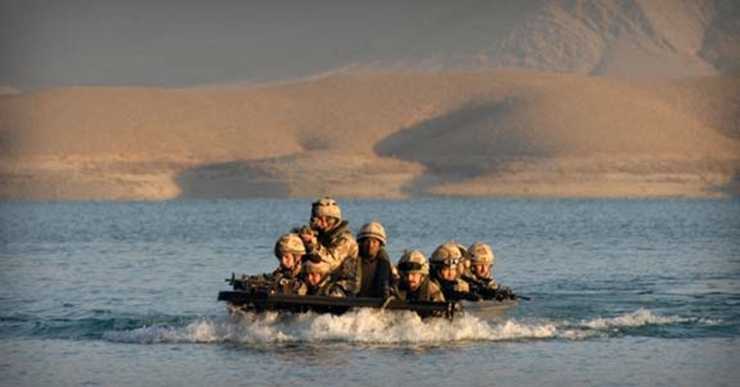The 2% myth
 (B2) This is the latest fashionable antiphon. He must that defense spending (public) should be up to 2% of gross domestic product.
(B2) This is the latest fashionable antiphon. He must that defense spending (public) should be up to 2% of gross domestic product.
This objective was set at the level of the Atlantic Alliance, regularly recalled at all summits (Wales September 2014, Warsaw July 2016). James Mattis, the new Secretary of State for Defence, recalled this again when he came to NATO: the American taxpayer should not pay for the European taxpayer... Every country must make “immediate and steady” progress towards this goal.
A reality or an illusion
2% is a mythical figure... It is a bit to defense what the "3% deficit" of the stability pact is to the economy: a crest line but also a certain illusion. This is the guarantee, according to its promoters, of an effective defense. We can doubt it. The increase in defense spending is not a guarantee of quality, efficiency, availability or willingness to commit. The previous years of European history have proven this. And we can still see it today by carrying out some comparative tests.
Effective at 1% and ineffective at 2%?
Expenditure rate does not mean military efficiency. Greece spends 2,38% of its budget on defense while at the other end of the scale, Luxembourg spends 0,44% of its GDP on defence. We cannot say that the former is really committed on the external level... Another example: Poland devotes 2% of its budget to defense while France commits 1,78% (1). In the light of European security and international threats, Polish defense has not yet really demonstrated a dynamic commitment unlike the French army. We can also look at Bulgaria or Portugal – which devote 1,35% of their GDP to defense – while Denmark devotes 1,17% to it. Here again, military effectiveness is undoubtedly reversed (NATO figures, forecasts for 2016).
A very partial figure
This figure of 2% is therefore far from being a panacea. Because it is only a percentage and has only a very limited value. It would also be necessary to examine the investment/equipment ratio on the personnel ratio, the ratio of research expenditure, the commitment to external operations or at the solidarity level... and the reality on the ground such as the political will. Which is otherwise more difficult to quantify and requires certain truths to be told. This figure also depends on volume and economic growth. Thus, the move to 2% of Germany's GDP, for example, would signify an otherwise substantial commitment and would give Berlin a dominant weight in European military engagement in the Alliance, in absolute value (read: Devote 2% of GDP to defense? How much will this new Grail cost?).
Europeans in search of efficiency
To be more effective, European states above all need to coordinate better in the context of their defense investments. Some persistent gaps (helicopters, intelligence, geospatial technology) are still not really filled. Everyone is already thinking of buying equipment - after all similar (tanks, armored vehicles, fighter planes) - which no doubt have their uses but which no longer have a monopoly on action on the ground - robots and drones doing their appearance —. Duplications are the rule.
Few ambitions for the future
European defense budgets are still hit by a (very) small part devoted to research & development / technology (R&D, R&T). This prevents any projection into the future. Knowing that equipment purchased today is valid for at least 20 years (or even 30, 40 or 50 years), we thus have the value of possible failures. While the lack of coordination between the different countries, the dispersal of armies, the fragmentation of European industry and the lack of will and incentives to develop it (2), remain principles written in stone, thus giving a double weakness to European budgets: small in volume and poorly coordinated.
The pierced basket of 2%...
Without resolving these points, respecting the 2% seems like filling a leaky basket... or is just good enough to allow American industrialists to dispose of their surpluses on the Old Continent and thus amortize their costs.
... for whose benefit?
The anthem, repeated month after month by various Alliance and American leaders, is certainly laudable – to force a necessary, additional effort for defense – but it also conceals an underlying objective. Spend more and very fast = buy what is available on the market, with a good quality/price ratio, tested in the field, guaranteed and... compatible with others = buy American. CQFD. America first... Or as MEP Arnaud Danjean explains (3): "If what we are being asked is to sign more contracts with American industry, let them tell us...".
(Nicolas Gros-Verheyde)
(1) The percentage calculated at NATO normally includes pensions (retirements), except in certain countries, Bulgaria for example. It may therefore differ from that mentioned elsewhere. The weight of these pensions is not negligible: in France, they represented in 2016 (with the sums paid to veterans), around a quarter of the budget: €10,33 billion out of a total ministry budget of €42,63 billion. €.
(2) Most European States have not established a European preference which remains taboo. In the absence of a national preference - always sought in the awarding of contracts - they prefer to go directly to the American preference. The French decision to buy the Famas is, in itself, a counter-example to this trend.
(3) in an interview at B2 to be published soon




TB. In my opinion, there is a couplet missing on nuclear power which, in the case of France, whose necessary upgrade will soon absorb part of the increase from 1,8 to 2% (assuming that it happens).
I largely agree with this analysis on the “false nose” of the 2% in which each country accounts for the expenditure items in its own hand (pensions for example, or even certain costs due to operations, etc.).
It should also be noted that the American injunction to the Europeans to spend more and quickly nationally in no way suggests that the Europeans could also spend better and more efficiently by pooling their forces. In fact, the new American president is breaking away from the traditional American ambivalence (support in principle for the EU, but a brake on concrete progress). The return to juxtaposed and powerless national sovereignties in Europe makes docile allies, where the EU can be a difficult partner. In this sense the American and Russian presidents come together to support the national-populisms of all kinds which will inevitably fragment the Europeans and make the misfortune of their gullible voters (and others!). It's time to call a spade a spade and tell our fellow citizens.
“…or is just good enough to allow American industrialists to dispose of their surpluses on the Old Continent and thus amortize their costs.”
All is said…
Our American friends take care of NATO/NATO, Europe of Defense, it is not their problem...
Sir,
It seems to me necessary to make some criticisms.
Incidentally, I do not believe that it is possible to uncorrelated the levels of military expenditure of the countries on the margins of Europe, namely, and for example, Greece and Poland for whom the perception of the threats represented by Turkey and Russia are not strictly the same as for countries in the “second curtain” (time of the East-West conflict (1947 – 1991), even in the third curtain. And again, I note that the Netherlands, by example, after having abandoned the main battle tank and having considered doing the same for submarines, come back to the opposite choices in recent years. Geostrategically there is therefore a cause and effect link between geography and ambition to reach or exceed the level of military expenditure set by the Atlantic Alliance.
Also, in my modest research, I had not retained a “2%” objective but the “NATO V2 standard”. The latter does not include expenditure for the Gendarmerie (except 5% representing some more military missions than others) and pensions. So that, in this perspective, France must be at something, currently, like 1,4% of expenditure and not 1,78. So that, to tangent or exceed the Atlantic objective then it would no longer need a budget including tax of 42 billion euros but of around 60 billion euros since the NATO V2 standard requires increasing from 1,4 to 2 % our expenses relating mainly to equipment and training. The excluded expenses are then added.
And the financial effort is strictly not the same. On the other hand, at this level of expenditure and without changing the white paper or the operational contract, France has reached the model, for once.
Also, what does not emerge from these lines but from the comment above is that the increase in military expenditure as proposed in France by several political parties and candidates for the presidential election covers or covers only half the volume financial requirements for the modernization of nuclear deterrence. This consumed 3,5 billion euros per year and by 2020 should consume nearly 6 to 7 billion euros per year. It seems that it would even be the low end of the range. In such a perspective, the proposed budget increase only covers nuclear deterrence.
Also, it is necessary to note that if Germany comes from 1,3 to 2% (without the NATO V2 standard or with?) then it will become a military giant in Europe since it does not have the same GDP as the France nor a nuclear deterrent to modernize. Proportionally, its conventional forces will become much more employable and numerous. Today, the Defense MittelEuropa makes sense from the Baltic to the Carpathians.
Sincerely,